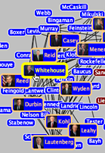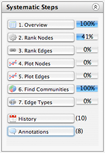RECENT RESEARCH PROJECTS
 |
Integrating Statistics and Visualization: Case Studies of Gaining Clarity during Exploratory Data Analysis
Although both statistical methods and visualizations have been used by network analysts, exploratory data analysis remains a challenge. We propose that a tight integration of these technologies in an interactive exploratory tool could dramatically speed insight development. To test the power of this integrated approach, we created a novel social network analysis tool, SocialAction, and conducted four long-term case studies with domain experts, each working on unique data sets with unique problems. The structured replicated case studies show that the integrated approach in SocialAction led to significant discoveries by a political analyst, a bibliometrician, a healthcare consultant, and a counter-terrorism researcher. Our contributions demonstrate that the tight integration of statistics and visualizations improves exploratory data analysis, and that our evaluation methodology for long-term case studies captures the research strategies of data analysts.
Adam Perer, Ben Shneiderman: Integrating Statistics and Visualization: Case Studies of Gaining Clarity during Exploratory Data Analysis. ACM Conference on Human Factors in Computing Systems (CHI 2008) 
|
 |
Systematic Yet Flexible Discovery: Guiding Domain Experts through Exploratory Data Analysis
During exploratory data analysis, visualizations are often useful for making sense of complex data sets. However, as data sets increase in size and complexity, static information visualizations decrease in comprehensibility. Interactive techniques can yield valuable discoveries, but current data analysis tools typically support only opportunistic exploration that may be inefficient and incomplete.
We present a refined architecture that uses systematic yet flexible (SYF) design goals to guide domain expert users through complex exploration of data over days, weeks and months. The SYF system aims to support exploratory data analysis with some of the simplicity of an e-commerce check-out while providing added flexibility to pursue insights. The SYF system provides an overview of the analysis process, suggests unexplored states, allows users to annotate useful states, supports collaboration, and enables reuse of successful strategies. The affordances of the SYF system are demonstrated by integrating it into a social network analysis tool employed by social scientists and intelligence analysts. The SYF system is a tool-independent component and can be incorporated into other data analysis tools.
Adam Perer, Ben Shneiderman: Systematic Yet Flexible Discovery: Guiding Domain Experts through Exploratory Data Analysis. International Conference on Intelligent User Interfaces (IUI 2008)  |
 |
SocialAction: Balancing Systematic and Flexible Exploration of Social Networks
With Ben Shneiderman
SocialAction is a system that uses attribute ranking and coordinated views to help users systematically examine numerous Social Network Analysis (SNA) measures. Users can (1) flexibly iterate through visualizations of measures to gain an overview, filter nodes, and find outliers, (2) aggregate networks using link structure, find cohesive subgroups, and focus on communities of interest, and (3) untangle networks by viewing different link types separately, or find patterns across different link types using a matrix overview. SocialAction offers analysts a strategy beyond opportunism, as it provides systematic, yet flexible, techniques for exploring social networks. More details are on the SocialAction webpage.
Adam Perer, Ben Shneiderman: Balancing Systematic and Flexible Exploration of Social Networks. IEEE Transactions on Visualization and Computer Graphics (InfoVis 2006). 12(5): 693-700 (2006)  |
|
Portraits of Email Practices
With Microsoft Research's Marc Smith
Over time, many people accumulate extensive email repositories that contain detailed information about their personal communication patterns and relationships. We created three visualizations that capture hierarchical, correlational, and temporal patterns present in user’s email repositories. These patterns are difficult to discover using traditional interfaces and are valuable for navigation and reflection on social relationships and communication history. We interviewed users with diverse email habits and found that they were able to interpret these images and could find interesting features that were not evident to them through their standard email interfaces. The images also capture a wide range of variation in email practices. These results suggest that information visualizations of personal communications have value for end-users and analysts alike.
Adam Perer, Marc A. Smith: Contrasting portraits of email practices: visual approaches to reflection and analysis. International Conference on Advanced Visual Interfaces (AVI 2006): 389-395  |
|
Beyond Threads: Identifying Discussions in Email Archives
With Ben Shneiderman
We designed a new technique to allow email archive explorers the ability to identify discussions. By presenting visualizations that go beyond the threads of email, explorers can become aware of messages that would have otherwise been hidden. Our legible visualizations present relevant temporal and social data that provides explorers with an enhanced opportunity to understand discussions evidenced in email
archives.
Adam Perer, Ben Shneiderman. Beyond Threads: Identifying Discussions in Email Archives. IEEE Symposium on Information Visualization (InfoVis 2005). (2005).  |
|
Rhythms of Relationships in Email Archives
With Ben Shneiderman and Douglas Oard
Historians and social scientists believe that email archives are important artifacts for understanding the individuals and communities they represent. In order to understand the conversations evidenced in an archive, context is needed. We present a new way to gain this necessary context: analyzing the temporal rhythms of social relationships. We provide methods for constructing meaningful rhythms from the email headers by identifying relationships and interpreting their attributes.
Adam Perer, Ben Shneiderman, Douglas W. Oard: Using rhythms of relationships to understand e-mail archives. Journal of the American Society for Information Science and Technology (JASIST) 57(14): 1936-1948 (2006)  |

|
Icon Abacus and Ghost Icons
With Palo Alto Research Center's Eric Bier
Two-dimensional icon layouts are a familiar way to present information about the documents in a collection. We designed two techniques that make collection visualizations more informative. Icon abacus uses the horizontal position of icon groups to communicate additional document attributes. Ghost icons show which documents are linked from a selected one by adding
temporary icons and by highlighting or dimming existing ones.
Eric Bier, Adam Perer. Icon Abacus: positional display of document attributes. Proceedings of the 5th ACM/IEEE Joint Conference on Digital Libraries (JCDL 2005): 289-290 
Eric Bier, Adam Perer. Icon Abacus and Ghost Icons. Proceedings of the 5th ACM/IEEE Joint Con-ference on Digital Libraries (JCDL 2005). (2005).  |
RECENT PHOTOS
|
|
PHOTO HIGHLIGHTS
Excursion in the Canaries
Gran Canaria, Canary Islands, January 2008 > click
My Month in Tel Aviv
Israel, October & November 2007 > click
Summer Vacation in Paradise
Costa Rica, July 2007 > click
Road Trip to Big Sur
California, USA, April 2007 > click
Winter Break in Scottsdale and Sedona
Arizona, USA, January 2007 > click
Hanging out in Paris
Paris, France, October 2006 > click
Conferencing in Montreux and Geneva
Switzerland, October 2006 > click
Rome, Florence and Venice
Italy, May 2006 > click
Montreal and Vancouver
Canada, April 2006 > click
Summer Vacation in India
India, August 2005 > click
Winter Break in Poland and Israel
Israel and Poland, January 2005 > click
Highlights from Vienna
Vienna, Austria, April 2004 > click
Spring Break in London and Paris
London and Paris, March 2003 > click |
|
|

